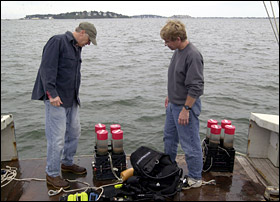
|
 |
Research > Centers
> WHOI Sea Grant Program
WHOI Sea Grant Program
 |
 |
|
Bill Martin (right), WHOI Marine Chemistry and Geochemistry Department, and Mike Bothner, U.S. Geological Survey, recover push cores from a Sea Grant-supported study of possible links between sewage output and trace metals in surface sediments. (Photo by Dan S. Blackwood, USGS) |
The WHOI Sea Grant Program supports research, education, and
extension projects that encourage environmental stewardship,
long-term economic development, and responsible use of the nation’s
coastal and ocean resources. It is part of the National Sea
Grant College Program of the National Oceanic and Atmospheric
Administration, a network of 30 individual programs in each
of the coastal and Great Lakes states. Their purpose is to foster
cooperation between government, academia, industry, scientists,
and the private sector.
With an annual budget of just under $1 million, WHOI Sea Grant supports approximately 10 concurrent
research projects in the areas of environmental
technology, estuarine and coastal processes, and fisheries and aquaculture. In addition, Sea Grant provides
seed money for “new initiative” efforts to take the first steps into promising new areas. Sea Grant research addresses local and regional needs, and many projects have national or even global implications.
In 2003, research topics included:
- Possible effects of low-level contamination on key developmental stages of Atlantic salmon;
- Lobster and squid population structures, comparing offshore and near-shore populations, and potential fisheries management impacts;
- Soft-shell clam populations and the role of tidal exchange in larval dispersal and its impact on regional recruitment by using natural tags;
- Chemical pollutants and their effects on marine invertebrates,
mammals, and fish;
- Land-derived nitrogen and its effects on commercially
important bivalves such as quahogs, soft-shell clams, and bay scallops;
- Groundwater as a transport mechanism for nutrients
and contaminants flowing into estuarine systems;
- Tidal marshes as a net sink for nitrogen and a source of nitrogen release within estuarine systems;
- Metal accumulation in sediments as a result of Boston Harbor sewage discharge;
- Aquatic nuisance species and the economic effects associated with their introduction;
- Use of scanning electron microscopy to understand causes and implications of lobster shell disease on the animal and the fishery.
In addition to research, WHOI Sea Grant supports
a marine extension program and an outreach/education program. Through those efforts, research is transmitted to a variety of audiences through publications,
Web sites, workshops, and lectures. Many Sea Grant outreach programs involve partnerships, such as with the Barnstable County Cooperative Extension Service, to provide technical expertise and demonstration projects on shellfish aquaculture and coastal processes.
A recent partnership with the Waquoit Bay National Estuarine Research Reserve (WBNERR) and the Massachusetts Coastal Zone Management Program is designed to provide research-based training
to Massachusetts coastal policymakers (see www.coastaltraining.org). In the ocean science education field, WHOI Sea Grant has partnered with colleagues
at New Hampshire Sea Grant to provide
marine career information to students
WHOI Sea Grant Program (www.marinecareers.net), and with the WHOI Coastal Ocean Institute and WBNERR to provide teacher workshops using coastal research, technology,
and instrumentation. WHOI Sea Grant is also involved with the New England Center for Ocean Science Education Excellence, a partnership between
the New England Aquarium, the University of Massachusetts, and WHOI.
—Judith E. McDowell (jmcdowell@whoi.edu)
WHOI Sea Grant Program Director
|
|
